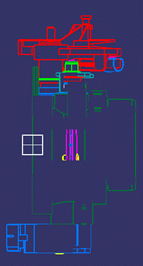HLR | ||
| ||
About HLR Algorithms
Two HLR algorithms can be used to compute a HLR scene: an exact mode and a polyhedral mode.
- Exact mode uses exact geometry
- Polyhedral mode enables to compute HLR on non-exact geometry that can be found in third-party data, in CGR files (when working with the cache system, for instance) or in specific Version 4 elements.
The Exact mode is more CPU- and memory-intensive than the Polyhedral mode but gives a more accurate result.
HLR and Dynamic Hidden Line Removal are not computed the same way because Dynamic Hidden Line Removal is primarily based on the graphics card. Therefore, discrepancies might appear between the two results.
For instance, on screen in 2D Layout for 3D Design in HRD mode, the intersection profile of an object with a front cutting plane or a back clipping plane is not displayed. However, the HLR print result shows this intersection profile:
| Shading with Edges | HRD | HLR |
|---|---|---|
 |
 |
 |
Regarding transparent faces, HLR algorithms consider them as opaque which means that objects behind these faces are hidden. On the contrary, the HRD rendering mode considers transparent faces as completely transparent by default. To force the HRD mode to consider transparent faces as opaque, use the Display transparent faces as opaque in HRD mode option in .
![]()
Restrictions
Some restrictions apply to the Exact and Polyhedral modes.
Exact mode
Note that:
- HLR behaves badly when the Display all elements using Z-buffer depth option is selected in .
- HLR behaves badly with points, certain kinds of line, texts and images as soon as they are in Z mode (i.e. they participate in the Z-buffer).
- Smooth edges cannot be removed when using HLR if the
three following conditions are fulfilled at the same time:
- The model has been designed in Version 5 (e.g. a CATPart).
- The model was first created before V5R16.
- The session uses the cache management OR only the CGR file of the CATPart model is inserted in the Product, not the CATPart itself.
- Smooth edges cannot be removed when using HLR if the window viewpoint is CONIC.
As this mode is based on exact geometry, the result is more precise. However as explained above, this mode is CPU- and memory-intensive and some restrictions might occur in specific cases. For instance, you might encounter problems with clashing bodies because some geometrical elements might not be generated. To by-pass this limitation, you can manually resolve the intersection topology using an appropriate sequence of Boolean operations.
In Exact mode, the smoothness of edges is not taken into account and therefore, cannot be switched off or on.
Polyhedral mode
In this mode, the geometry's complexity (in terms of number of triangles for each face of a surface) is limited. Attributes applied to edges, such as the linetype or the thickness, are those of the original edges as far as possible. When it is not possible to use the original attributes, default attributes are applied instead.
In Polyhedral mode, the smoothness of edges is not taken into account and therefore, cannot be switched off or on.
![]()
Specific Behavior
There is a specific behavior when working with the 2D Layout for 3D Design or the DMU Sectioning product.
When working with the , the or the command in a 2D Layout for 3D Design or DMU Sectioning context, the polyhedral HLR mode is used. In this case, some specific geometry elements such as curved pipes or cylinders might not be affected by clipping views, sections or polygonal traps during the HLR rendering process.
See the 2D Layout for 3D Design User's Guide for more information about clipping commands and the DMU Sectioning User's Guide for more information about sectioning.